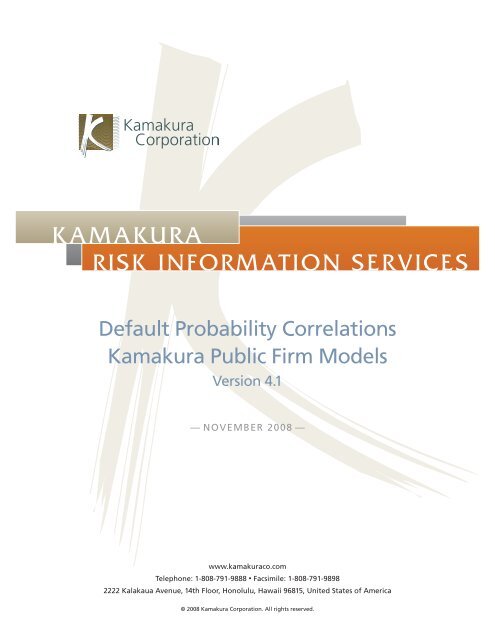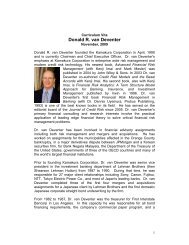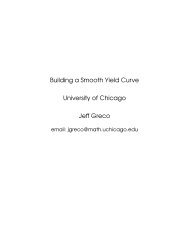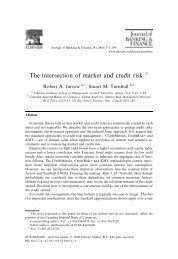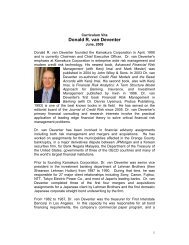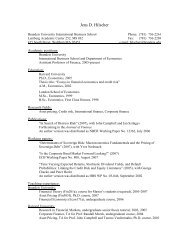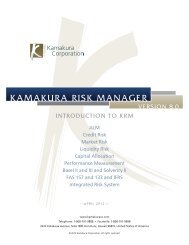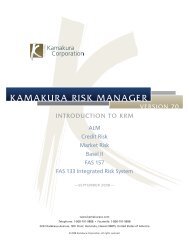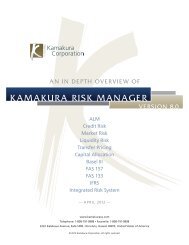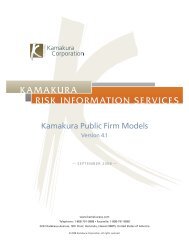kamakura risk information services - The Kamakura Corporation
kamakura risk information services - The Kamakura Corporation
kamakura risk information services - The Kamakura Corporation
Create successful ePaper yourself
Turn your PDF publications into a flip-book with our unique Google optimized e-Paper software.
KAMAKURA<br />
RISK INFORMATION SERVICES<br />
VERSION 7.0<br />
Default Probability Correlations<br />
<strong>Kamakura</strong> Public Firm Models<br />
Version 4.1<br />
— NOVEMBER 2008 —<br />
www.<strong>kamakura</strong>co.com<br />
Telephone: 1-808-791-9888 • Facsimile: 1-808-791-9898<br />
2222 Kalakaua Avenue, 14th Floor, Honolulu, Hawaii 96815, United States of America<br />
© 2008 <strong>Kamakura</strong> <strong>Corporation</strong>. All rights reserved.
Contents<br />
I. Introduction<br />
II. KRIS Default Probability Correlations<br />
III. KRIS Default Correlations<br />
IV. KRIS Public Firm Models: A Summary<br />
V. <strong>The</strong> Jarrow Chava Model<br />
VI. Merton Structural Model<br />
VII. Jarrow Merton Hybrid Model<br />
VIII. About <strong>Kamakura</strong> <strong>Corporation</strong><br />
2<br />
© 2008 <strong>Kamakura</strong> <strong>Corporation</strong>. All rights reserved.
I.<br />
Introduction<br />
<strong>Kamakura</strong> Risk Information Services public firm default probabilities were launched in<br />
November 2002, followed by the KRIS Sovereign Default Service in 2008. <strong>The</strong> KRIS service<br />
provides estimates of the full term structure of default probabilities of an individual public<br />
firm based upon current public <strong>information</strong> about the firm, its economic environment, firmspecific<br />
financial ratios and equity market inputs. Maturities are available 1 month, 3 months,<br />
6 months, 1 year, 2 years, 3 years, and 5 years.<br />
KRIS default probabilities are utilized by major corporations and financial institutions<br />
in Europe, Asia and the Americas for two major purposes: monitoring the <strong>risk</strong> of single<br />
counterparties and monitoring the <strong>risk</strong> of large portfolios of counterparties whose default<br />
<strong>risk</strong> is highly likely to be correlated. <strong>The</strong> KRIS default probability service contains the pairwise<br />
correlation of every pair of companies covered in the KRIS service. In the next section,<br />
we discuss these correlations and their use in modern portfolio management.<br />
II.<br />
KRIS Default Probability Correlations<br />
Many market participants talk about three different definitions of default “correlation” as if<br />
they were interchangeable:<br />
Asset correlation: the correlation in the returns on company assets for two firms, for<br />
example Lehman Brothers and Bear Stearns, in a Merton or copula modeling context.<br />
Correlation in the event of default: the correlation between a variable that is 0 in a nondefaulting<br />
period and 1 in the defaulting period. Such a variable would be 0 for every<br />
observation prior to the defaulting period and one in the period in which the firm defaults.<br />
For two firms that have not gone bankrupt, these variables contain nothing but zeros and this<br />
definition of correlation is problematic.<br />
Correlation in the default probabilities themselves: the simple correlation in the time<br />
series of default probabilities for two firms, such as Lehman Brothers and Bear Stearns.<br />
Each of these correlations could potentially be useful, depending on the nature of the<br />
portfolio simulation that the user chooses. If the user feels that default probabilities are<br />
constant, a common assumption in the copula approach, then one would use the first<br />
definition of correlation. If one were modeling default probabilities that are random and<br />
rise and fall over the business cycle, then one would use the third definition. Robert Jarrow<br />
and Donald R. van Deventer showed that these alternative definitions of default correlation<br />
are mathematically linked (see “Estimating Default Correlations Using a Reduced Form<br />
Model,” Risk Magazine, January, 2005). <strong>The</strong> KRIS default probability service includes default<br />
correlations to aid analysts who are modeling enterprise credit <strong>risk</strong> either in the <strong>Kamakura</strong><br />
Risk Manager system or some other system.<br />
3<br />
© 2008 <strong>Kamakura</strong> <strong>Corporation</strong>. All rights reserved.
III.<br />
KRIS Default Correlations<br />
<strong>The</strong> KRIS default probability service provides correlations in the default probabilities of any<br />
pair of public firms for each of the four default models described below, each of which has 7<br />
different maturities of default probabilities available (note only 1 year maturities are available<br />
for the Merton model because of the single period nature of that model). All together, more<br />
than 4.85 million pair-wise default probability correlations are available in KRIS at its 2008<br />
level of coverage: 21,000 public firms in 30 countries.<br />
Default correlations have much in common with the beta calculation commonly used in the<br />
capital asset pricing model and extensions of that model for equity portfolio management.<br />
In the equity market, betas are commonly estimated using 60 months of historical data.<br />
Using this convention as a precedent, <strong>Kamakura</strong> measures default probability correlations<br />
incorporating 60 months of historical data for each pair of companies. <strong>Kamakura</strong> is pleased<br />
to include other correlation definitions at the request of a serious user. Jarrow and van<br />
Deventer (2005) show how to convert this correlation figure to alternative definitions of<br />
correlation described above.<br />
<strong>The</strong> KRIS default probability correlations are essential to ensuring accurate simulation<br />
of portfolio credit <strong>risk</strong>, whether the portfolio is a traditional bank loan portfolio or a<br />
collateralized debt obligation. It is important to know, for example, that Citigroup and<br />
Ford have a default probability correlation in excess of 70% in addition to the obvious 88%<br />
correlation in the default probabilities of Ford and General Motors. Analysts who simulate<br />
portfolio credit <strong>risk</strong> without taking advantage of these insights run the <strong>risk</strong> of seriously<br />
underestimating total credit <strong>risk</strong>, the same error that led to the failure of so many firms in the<br />
2007–2008 crisis.<br />
<strong>The</strong> remainder of this brochure summarizes the main types of default models available under<br />
the KRIS default probability service.<br />
IV.<br />
KRIS Public Firm Models: A Summary<br />
<strong>Kamakura</strong>’s Public Firm Models currently offer four different quantitative approaches to<br />
modeling default probabilities: two versions of the Jarrow Chava Model (KDP-jc), the<br />
Merton Structural Model (KDP-ms), and the Jarrow Merton Hybrid Model (KDP-jm).<br />
Both the third generation (version 3.0, released in October 2004) and the fourth generation<br />
(version 4.1, released January 9, 2006) of the Jarrow-Chava models are available on the<br />
web site at the request of the KRIS client base. All approaches incorporate <strong>information</strong><br />
on market prices of firm equity and interest rates so that current market expectations are<br />
fully reflected in the default probability estimates. <strong>The</strong> availability of multiple Public Firm<br />
Models provides subscribers with theoretically sound alternative views on the likelihood a<br />
particular firm will default.<br />
4<br />
© 2008 <strong>Kamakura</strong> <strong>Corporation</strong>. All rights reserved.
V.<br />
VI.<br />
VII.<br />
<strong>The</strong> Jarrow Chava Model<br />
<strong>The</strong> Jarrow Chava Model is a statistical hazard model that relates the probability of firm<br />
default to several explanatory variables. <strong>The</strong> explanatory variables include firm financial<br />
ratios, other firm attributes, industry classification, interest rates and <strong>information</strong> about firm<br />
and market equity price levels and behavior. In this model, firm default can occur randomly<br />
at any time with an intensity determined by the explanatory variables. Originally developed<br />
by <strong>Kamakura</strong>’s Director of Research, Robert Jarrow, the Jarrow Chava Model provides an<br />
objective, statistically reliable method of predicting potential firm defaults. <strong>The</strong> Federal<br />
Deposit Insurance <strong>Corporation</strong> of the United States announced in December 2003 that it was<br />
adopting the methodology incorporated in the Jarrow Chava Model for its Loss Distribution<br />
Model for the bank and savings and loan insurance funds. Both the third and fourth<br />
generation Jarrow-Chava models incorporate multiple equations for forecasting default<br />
at different forward time intervals, conditional on survival to that point in time. <strong>The</strong>se<br />
equations share the same inputs but they have different weightings depending on the time<br />
horizon. <strong>The</strong> current and forward conditional default probabilities are combined to derive<br />
the full default term structure out to five years.<br />
Merton Structural Model<br />
<strong>The</strong> Merton Structural Model uses option pricing methods to relate the probability of firm<br />
default to its financial structure and <strong>information</strong> about the firm’s market price of equity. <strong>The</strong><br />
explanatory variables include a measure of the firm’s outstanding debt, its market valuation,<br />
and <strong>information</strong> about firm and market equity price behavior. In this model, firm default<br />
occurs when the market value of the firm’s assets decline below a threshold related to the<br />
firm’s outstanding debt. Robert Merton, winner of the Nobel Prize in Economic Sciences in<br />
1997, originally developed this model.<br />
Jarrow Merton Hybrid Model<br />
<strong>The</strong> Jarrow Merton Hybrid Model is a statistical hazard model that relates the probability<br />
of firm default to the same explanatory variables as the Jarrow Chava Model, but it also<br />
incorporates the default probability of the Merton Structural Model as an additional<br />
explanatory variable. In this model, firm default can occur randomly at any time with an<br />
intensity determined by the explanatory variables. <strong>Kamakura</strong> offers this Model to combine<br />
the default prediction capabilities of the associated models. Forward default probabilities<br />
and the full term structure of default are derived in the same fashion as for the Jarrow-<br />
Chava models.<br />
5<br />
© 2008 <strong>Kamakura</strong> <strong>Corporation</strong>. All rights reserved.
VIII.<br />
About <strong>Kamakura</strong> <strong>Corporation</strong><br />
Founded in 1990, <strong>Kamakura</strong> <strong>Corporation</strong> is a leading provider of <strong>risk</strong> management<br />
<strong>information</strong>, processing and software. <strong>Kamakura</strong> has been a provider of daily default<br />
probabilities and default correlations for listed companies since November, 2002. <strong>Kamakura</strong><br />
launched its collateralized debt obligation (CDO) pricing service KRIS-CDO in April 2007.<br />
<strong>Kamakura</strong> is also the first company in the world to develop and install a fully integrated<br />
enterprise <strong>risk</strong> management system that analyzes credit <strong>risk</strong>, market <strong>risk</strong>, asset and liability<br />
management, transfer pricing, and capital allocation. <strong>Kamakura</strong> has served more than<br />
185 clients ranging in size from $3 billion in assets to $1.6 trillion in assets. <strong>Kamakura</strong>’s<br />
<strong>risk</strong> management products are currently used in 27 countries, including the United States,<br />
Canada, Germany, Russia, the Netherlands, France, Switzerland, the United Kingdom,<br />
Eastern Europe, the Middle East, Africa, Australia, Japan, China, Korea and many other<br />
countries in Asia.<br />
<strong>Kamakura</strong>’s research effort is led by Professor Robert Jarrow, who was named Financial<br />
Engineer of the Year in 1997 by the International Association of Financial Engineers.<br />
Professor Jarrow and <strong>Kamakura</strong> founder Dr. Donald R. van Deventer were both named to<br />
the 50 member RISK Hall of Fame in December 2002. <strong>Kamakura</strong> management has published<br />
more than 100 publications on credit <strong>risk</strong>, market <strong>risk</strong>, and asset and liability management.<br />
<strong>Kamakura</strong> has world-wide distribution alliances with Fiserv (www.fiserv.com), Unisys (www.<br />
unisys.com), and Zylog Systems (www.zylog.co.in) making <strong>Kamakura</strong> products available in<br />
almost every major city around the globe.<br />
2222 Kalakaua Avenue, 14th Floor<br />
Honolulu, Hawaii 96815<br />
United States of America<br />
Telephone: 1-808-791-9888<br />
Facsimile: 1-808-791-9898<br />
Information: info@<strong>kamakura</strong>co.com<br />
www.<strong>kamakura</strong>co.com<br />
6<br />
© 2008 <strong>Kamakura</strong> <strong>Corporation</strong>. All rights reserved.


